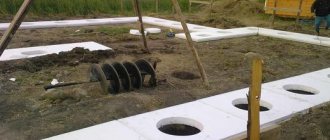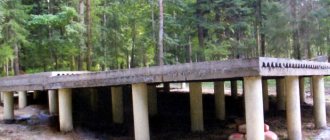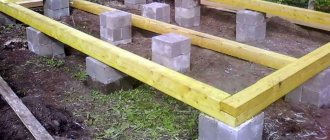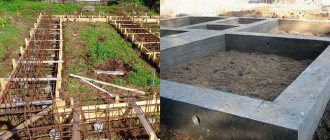When designing the foundation of a future bathhouse, garage or house, you need to approach it very carefully. The soil type, seismic situation in the region, groundwater occurrence and much more are taken into account. On some soils it is very difficult to build an expensive strip foundation. Sometimes even the most durable structures at first glance begin to “float” or simply crack.
There is an option for a pile foundation. But it is also not suitable for every soil. Or you can use tires and build a fairly cheap and durable foundation. However, many are confused by this option, since it is not entirely clear how exactly old tires can perform such an important function. Let's take a closer look.
Why do people choose tire foundations?
Among the main advantages of tires, it is worth highlighting their durability. These products are made of several layers of rubber and can withstand enormous loads. Since they are mostly hidden from direct sunlight, there is no fear that they will deteriorate and crumble. The average car tire has a service life of more than 80 years.
Such a foundation also has many other advantages. For example,:
- Low cost. By and large, you only need to pay the most for the tires themselves (it’s cheaper to buy used ones) and for cement. When compared with a strip foundation, for which you will have to build formwork and purchase expensive reinforcement, a tire foundation becomes the most budget option.
- Low labor intensity. Yes, of course, you will have to wave a shovel and thoroughly compact such a foundation, but it is still faster than digging a trench and tying up reinforcement. True, in this case the pile foundation still wins. It is being built the fastest.
- No need to use heavy construction equipment. For a strip foundation you will have to hire an excavator, and for a pile foundation you will have to pay for the services of a pile driving machine. For a foundation made of tires, you will generally need a shovel and a regular car jack.
- Resistant to deformation over time. Thanks to their material, tires do not lose their integrity throughout the entire period of operation. They withstand seasonal ground movement. For the same reason, such a foundation is optimal for areas in areas with low seismic resistance.
It is also worth highlighting the large area of the resulting support. This type of foundation is suitable for a bathhouse, gazebo, small house, terrace, summer veranda, garage and many other buildings.
Are there any disadvantages
There really aren't many downsides to a tire foundation. The most important of them is that tires are completely unsuitable for load-bearing walls. In this case, difficulties will arise in the process of cladding the building.
The second minus is rather not a minus, but a necessity. To build such a foundation (even though the tires are made of moisture-resistant material) you will need a layer of waterproofing. You should not lay the wheels directly on the ground. In summer, during the heat, the soil becomes very hot. Because of this, tires begin to emit not the most beneficial fumes.
Therefore, all that remains is to choose a specific type of this simple foundation and get to work.
Positives and negatives
Different types of building materials have their own advantages and disadvantages. The foundation for a building, the basis of which is worn out tires, is no exception. Let's look at the advantages of constructing from old tires:
- Significant savings in financial resources due to the absence of the need to use expensive building materials. Finding used rubber tires is not difficult. They are available in abundance at tire installation sites and service stations. Old tires will be gladly given away by service workers, for whom your request is a free solution to the disposal problem.
- Long service life of the foundation built on the basis of automobile ramps. It will withstand the load of a wooden house. Despite wear and tear, old tires used for construction purposes have a significant service life and retain their quality. Shock-absorbing properties ensure that the elasticity coefficient remains constant, regardless of the duration of tire operation.
- Resistance of tires, protected from direct sunlight, to the effects of high soil moisture and repeated cycles of deep freezing, which do not affect the structure of the slopes used as the basis of the building.
- Ensuring reliable waterproofing of the building’s base from increased soil moisture and the negative impact of nearby aquifers.
For a house installed on a foundation made of tires, moisture is not a problem. A reliable waterproofing base contributes to a favorable indoor microclimate. Few people know how to make a foundation from tires, so this technology is available to those who have at least once encountered this process - The ability to compensate for ground vibrations for buildings erected in areas with increased seismic activity. The tire foundation is a damping cushion that protects the building walls from impacts associated with seismic phenomena and seasonal temperature fluctuations.
Despite many positive aspects, tire bases when exposed to direct sunlight release harmful substances into the atmosphere. The emission of harmful components that make up rubber is felt organoleptically if the slopes are located above the zero mark and are not protected from the air space by concrete. When creating a foundation from tires with your own hands, ensure reliable protection of the slopes from heat and contact with open air.
Features of arranging a foundation on heaving soil
If we are talking about soil that contains a lot of moisture or other types of “complex” soils, then it is very difficult to build a foundation on them. The soil rises unevenly throughout the year, so any foundation, even if tires are used for it, must be built in accordance with several recommendations.
For example, you can “remove” a layer of heaving soil and replace it with coarse sand, which is carefully compacted. In such soil, water will not stagnate, which means the soil will not freeze and swell. The second option is to “heat” the soil. To do this, you need to organize a layer of insulation between the soil and the foundation. Some simply build a drainage system to drain the water.
Nevertheless, the best option for heaving soil is a tire foundation. It can be laid without first removing the soil. True, in this case it will be necessary to completely pour concrete. This type of base is called tiled or solid.
Laying a slab foundation from tires
This base is made in 1-2 layers. The main stages of work will be as follows:
- We prepare the site for the foundation. To do this, we mark the territory, remove the fertile layer of soil and level the site using a building level. Usually it is enough to remove no more than 25 cm, so you can do it with a regular shovel. If you do not do this, the house will stand on the so-called humus. It contains a huge number of different bacteria and microorganisms, the vital activity of which will negatively affect the condition of the foundation. But there is no need to dig a pit that will be deeper than the freezing depth.
- We lay the tires next to each other on the prepared area, having previously laid a layer of waterproofing underneath them. They should all be the same height. It is advisable to purchase tires with a larger diameter (for example, bus or tractor tires), as they are stronger and will create a more stable base. If you are using large tires, then one layer is enough, but if you are building a foundation from car tires, then it is worth doing two layers.
- We fill the tires. All voids between the tires must be filled with fine gravel or broken bricks used. But it is not recommended to use sand for this. In this case, there is a risk that over time the foundation will begin to sag. The most convenient way to fill tires is with a car jack. It can be placed between the two beads of the tire and moved apart. Just don’t over-inflate the tires. It is also worth placing a small piece of geotextile on the bottom of each tire (if you decide not to lay a layer of waterproofing).
Healthy! The height of the foundation is determined based on the characteristics of the soil. For example, in marshy areas it is better to build a higher foundation. Only the foundation should be in contact with the ground, and not the building itself.
- Basement or underground. If you want to organize a basement, then consider its location at the stage of laying tires. The tires are not placed in the place where the underground will be.
- Laying roofing felt. You need to lay this roll material on a layer of tires (any other material can be used, but roofing felt has optimal characteristics and is the cheapest). This way we will get good additional waterproofing.
- We install the formwork. We build a wooden box around the entire perimeter of the base from tires. The height of the formwork must be at least 10 cm. It all depends on the height of the foundation itself. Some people also lay a layer of reinforcement after this, but you can do without it.
- Pouring concrete solution. We pour concrete evenly into the resulting wooden box (the entire solution must be poured in one stage so that the base gains strength evenly).
After 10 days, it will be possible to remove the formwork, but the foundation will gain full strength only on the 28th day.
This is a more complex option for arranging a foundation made of tires. If the soil is not so problematic, but you live in a region with high seismic activity, then you can build a different type of foundation.
Useful tips
When constructing a foundation from tires, follow the advice of experts:
- When choosing tire center filler, the strength and shock-absorbing properties of the base are taken into account. If you need a solid foundation, use broken bricks and crushed stone. Filling the tires with concrete helps make the base even stronger. When a foundation with high shock-absorbing properties is required, the center is filled with wet sand.
- If large-scale construction of a site with several objects is carried out, work begins with the simplest, lightest structure - a gazebo, outbuilding, etc. This will allow you to gain experience in base construction.
- There is no need to deepen the foundation. The depth of the base should be less than the freezing depth of the soil.
- The tires are fixed evenly, preventing movement. To level the tires, use a building level.
- The protruding parts of the foundation are finished with decorative materials. This allows you to protect the foundation from mechanical influences, increase its service life, and improve the aesthetics of the building.
Features of laying a columnar base
In this case, tires are used as supporting pillars of the structure, so the laying technology is very different. In this case, tires act as shock-absorbing elements. They dampen tremors, so you can avoid the appearance of cracks in future construction.
To create such a foundation you will need:
- Calculate exactly where the corners of the building will be. It is also worth purchasing tires from trucks for such a base. Car tires may not be able to withstand the load.
- Prepare the site. Also, as in the case of a slab foundation, it is recommended to remove the fertile layer of soil and get rid of tree roots, stones and other debris. It is worth removing about 30 cm of soil. After this, we dig a pit, the depth of which will be sufficient for two layers of tires (this type of base is made only in two layers). The bottom of the pit is leveled and compacted well. At the next stage, a layer of crushed stone is poured onto it and waterproofing is laid.
- Mark the territory. In the places where the supports will be installed, you need to drive in pegs (or use metal posts) and measure again so that the distance between future supports corresponds to the original plan. If there are serious deviations, the load will be distributed unevenly across the tires.
- We install tires. We put tires on the pegs, align them well so that they are centered and located at the same horizontal level. We install the second layer of tires and fill the resulting “wells” with crushed stone and broken bricks.
After this, the crushed stone is slightly moistened and the “wells” are filled with concrete mortar. When the concrete has hardened, you can lay roofing material on the tires and begin laying timber for the formwork and proceed to the construction of the main structure.
Laying technology
To successfully implement your plan, you need to prepare in detail. A project is drawn up, which includes a drawing. The structure of the soil is studied and the possible load is calculated. Based on the data obtained, the type of foundation is selected and an estimate is drawn up.
Slab
This foundation is perfect for frame-type residential buildings. It is advisable to select the largest wheels for it. Tires from tractors, buses and heavy trucks are well suited. The size of the material affects the stability and strength of the structure.
Many developers have doubts whether to fill the tire foundation with concrete or not. This is due to the fear that the design may not be entirely reliable. Meanwhile, calculations show that one stack of columnar base can withstand up to two tons of load. Filling with mortar is needed as needed - to obtain additional rigidity.
Pouring concrete over a tire base Source sakh.com
All work is done in stages:
- The site is cleared according to the size of the project.
- A pit is dug to a depth of at least 30 cm (fertile layer).
- The bottom of the pit is leveled using a building level.
- The slopes are laid flat in the pit, as tightly as possible.
- All voids are filled with construction waste, broken bricks, or better yet, gravel.
- A standard reinforced concrete floor is laid on the prepared base.
If large tractor wheels are used, then one row of tires in the pit is sufficient. The use of much smaller tires will require them to be laid in two rows. This must also be done if the soil is waterlogged. And experts do not recommend using sand to fill voids. It shrinks significantly.
Instead of floor slabs, pouring concrete is used. To do this, roofing material is spread over the tires and formwork is constructed. Reinforcement is carried out and filled with cement mortar. Let it sit for a week before starting to build the walls.
Filled tire for the foundation Source img-fotki.yandex.ru











